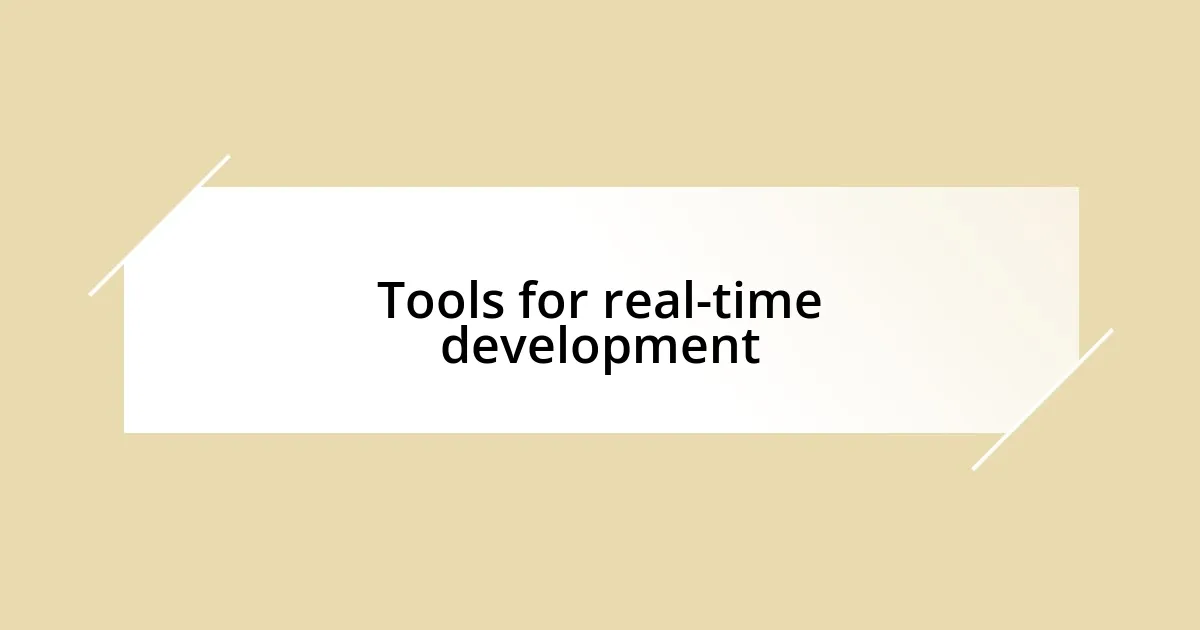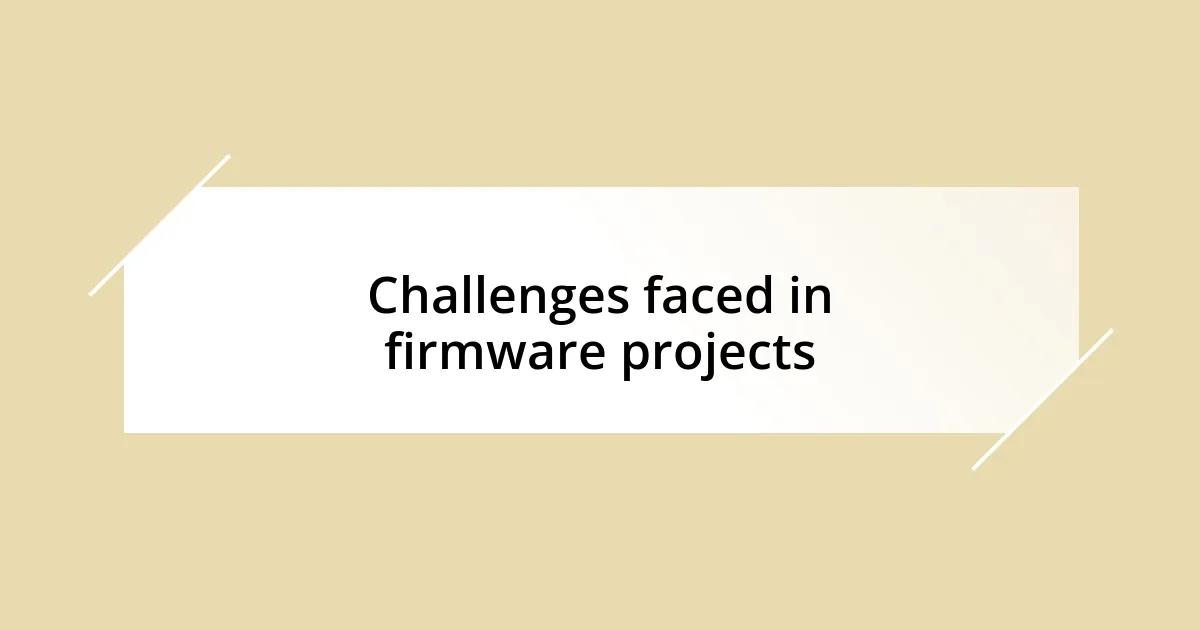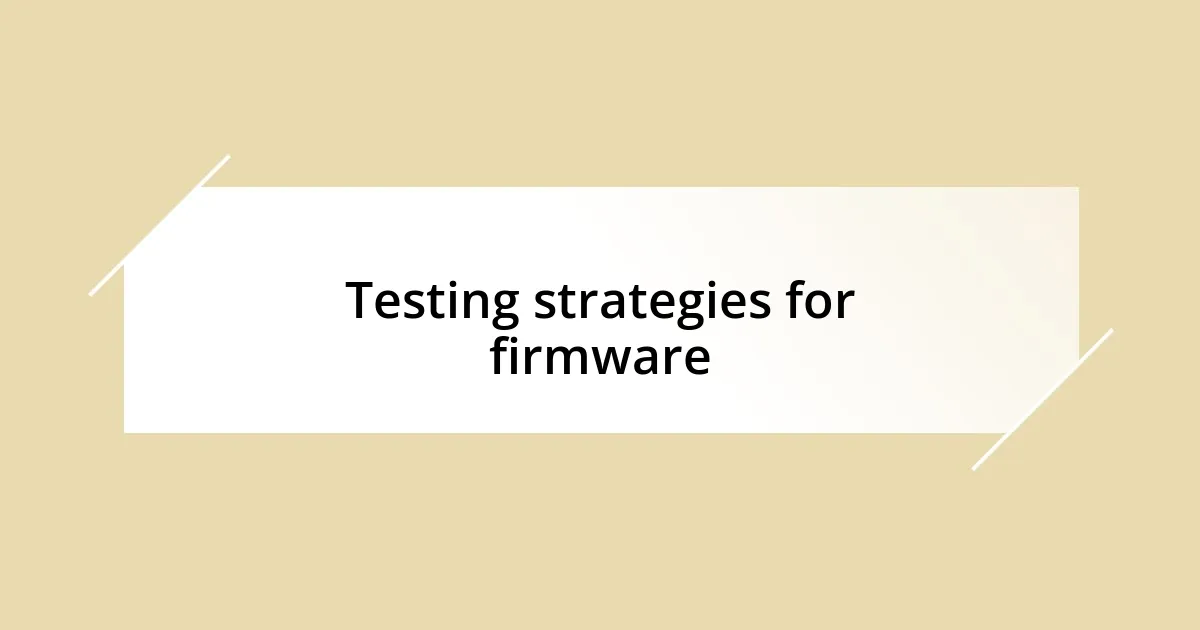Key takeaways:
- Real-time firmware requires precise timing to ensure functionality, demanding meticulous design and testing processes.
- Modular design enhances code maintainability and debugging efficiency, while rigorous testing prevents potential failures.
- Effective debugging involves systematic approaches, logging for insights, and stress testing to uncover hidden flaws.
- Clear communication, flexibility in planning, and taking breaks for creativity are essential for successful project outcomes.

Understanding real-time firmware
When I first dove into real-time firmware, I was struck by how critical timing is in this realm. Unlike standard firmware, real-time systems must respond to inputs or events within specific time constraints. This makes the design and testing process incredibly detailed; lapses in timing can compromise functionality, and that realization added a sense of urgency to my work.
I remember a project where the firmware controlled a set of motors in an industrial automation setup. If the response time slipped, even by a few milliseconds, it could lead to performance issues. This experience taught me that understanding the hardware, software interactions, and the inherent time requirements is foundational to successful real-time development. Have you ever worked on something where timing was the make-or-break factor?
Real-time firmware development isn’t just about logic; it’s about building trust in the system’s reliability. Knowing that my work directly impacts real-world applications, whether it’s medical devices or automotive systems, adds an emotional layer to the coding process. It’s a profound responsibility that drives me to meticulously design and validate each component, ensuring that every piece works harmoniously, just as perfectly as it needs to.

Key principles of firmware development
One key principle I’ve learned from my experience in firmware development is the importance of modular design. By breaking down the firmware into smaller, manageable components, I’ve found it easier to debug and maintain my code over time. This approach not only fosters a clear structure but also allows for quicker iterations, which can be crucial when making adjustments for timing or performance.
- Embrace modularity: This enhances readability and makes debugging simpler.
- Prioritize simplicity: Strive for straightforward designs that avoid unnecessary complexity.
- Test rigorously: Frequent testing at every stage can prevent cascading failures later.
The collaboration between hardware and software is another vital aspect that I’ve come to appreciate. Each time I work on a new project, I dive deep into the hardware specifications. There’s something satisfying about tweaking the software to optimize the performance of the hardware, creating a seamless interaction that makes the final product come alive. I remember feeling a wave of satisfaction the first time my code directly improved the response time of a sensor. That moment reinforced my understanding of how closely intertwined these elements are in real-time firmware development.

Tools for real-time development
When it comes to tools for real-time development, I’ve discovered a plethora of options that can significantly streamline the design and testing process. For instance, using integrated development environments (IDEs) tailored for real-time systems, like IAR Embedded Workbench or Keil µVision, has been invaluable. They provide robust debugging features, which I’ve personally found to be a lifesaver during troubleshooting. The clarity they offer when stepping through code can transform a daunting debugging session into a manageable task.
Another essential tool in my arsenal has been RTOS (Real-Time Operating Systems) such as FreeRTOS or Zephyr. These platforms help in organizing tasks and managing timing constraints effectively. I recall a specific project where using FreeRTOS enabled concurrent task management for multiple sensors; it was exhilarating to see everything sync up seamlessly. This experience reinforced my belief in the necessity of selecting the right tools to cater to the unique needs of real-time firmware.
Moreover, simulation tools like MATLAB/Simulink have also enriched my development experience. When timing and responses in my firmware needed precise validation, these tools helped visualized and simulate system behaviors before running them on actual hardware. I remember my first simulation, where I could fine-tune parameters in a risk-free environment, drastically reducing the potential for costly errors. The confidence they instilled during the development phase is something I cherish.
| Tool | Purpose |
|---|---|
| IAR Embedded Workbench | IDE with extensive debugging tools |
| FreeRTOS | RTOS for effective task management |
| MATLAB/Simulink | Simulation for system behavior analysis |

Challenges faced in firmware projects
As I delved into firmware projects, one of the significant challenges I encountered was aligning firmware development with the hardware capabilities. Have you ever poured hours into coding only to discover that the hardware couldn’t support your design choices? That moment can feel crushing, but I’ve learned to counter it by constantly collaborating with hardware engineers at the outset, ensuring that we share a mutual understanding of the limitations and possibilities. This proactive communication often saves time and frustration down the line.
Another hurdle I faced was managing memory constraints. It’s quite the balancing act to optimize code while fitting into a limited memory space. I recall a project where I underestimated the flash memory requirements, and my initial solution led to a frantic scramble to reduce code size. Calculating memory usage early on and continuously monitoring during development became my new norm. This experience taught me not just to be diligent but to embrace creative solutions, such as using data structures that offered better space efficiency.
Debugging in real-time can be daunting. Have you ever raced against a deadline while wrestling with elusive bugs? During one intense sprint, I realized I was spending more time guessing than solving. That’s when I started to implement systematic debugging strategies, relying on tools that helped me analyze states and transitions more closely. Those moments of clarity felt like a breakthrough—transformative, even! Debugging became less about frustration and more about discovery, and it profoundly reshaped my approach to problem-solving in firmware projects.

Best practices for effective debugging
I’ve learned that the first step in effective debugging is to have a systematic approach. Instead of diving blindly into code, I often take a step back and break down the problem. This might sound simple, but it’s surprisingly easy to get lost in the details when everything seems interconnected. I remember once tracking down a bug that turned out to be a minor typo in a variable name—it was a great reminder of how essential it is to carefully analyze each segment of code before going further.
One technique that has become my go-to is using logging effectively. By placing log statements at key junctures in my firmware, I’ve gained invaluable insights into the program’s flow. It’s like shining a light into dark corners of my code where bugs like to hide. During a particularly complex project involving multithreading, I found that these logs allowed me to see the exact order in which events were executed. This visibility made tackling tricky timing bugs much more manageable, transforming what could be a frustrating process into one of clarity.
Have you ever tried to debug an issue only to find that the root cause was completely unanticipated? I’ve had that experience more times than I care to admit, especially when dealing with hardware interactions. I picked up the habit of incorporating stress tests into my routine development process. By intentionally subjecting my firmware to unexpected inputs and loads, I’ve unearthed hidden flaws that might not have surfaced during standard testing. Embracing this unpredictable side of debugging has not only saved me from future headaches but has also infused my development process with a sense of excitement and discovery.

Testing strategies for firmware
Developing an effective testing strategy for firmware is crucial to ensuring reliability. I often rely on unit testing as a foundational approach. By creating small, isolated tests for each function, I can validate behaviors early in the development process. I remember a project where unit tests highlighted a critical error in my timing logic before it could cause any real-world issues. The relief was palpable—fixing it early saved not just time but potential headaches down the line.
Integration testing is another vital part of my strategy. Once individual components work perfectly in isolation, blending them poses its own challenges. I’ve encountered surreal moments when seemingly flawless modules collided in unexpected ways. There was one point where I assumed two perfectly functioning modules would play nicely together. Instead, I ended up spending days untangling miscommunications between them. I now make it a point to integrate progressively and test continuously, allowing me to catch integration issues sooner.
Let me not overlook the role of acceptance testing, particularly from a user’s perspective. After all, firmware needs to meet user needs and expectations, right? While working on a smart appliance project, I involved end-users in the testing phase. Their feedback was eye-opening! They uncovered usability flaws that I had completely overlooked. Engaging real users in testing not only enhances product quality but also fosters a connection between the developers and the users that can be incredibly rewarding.

Lessons learned from my projects
I’ve learned that one of the most valuable lessons in my project journey is the importance of clear communication with team members. There was a time when I assumed everyone was on the same page about certain firmware specifications, only to realize later that different interpretations led to significant delays. It made me appreciate how critical it is to establish a shared understanding early on— a lesson that I carry forward in every project. Have you experienced that awkward moment when assumptions lead to confusion? I definitely have, and now I make it a point to encourage open dialogue, ensuring that every voice is heard.
Another insight that has shaped my development process is the necessity of maintaining flexibility. There was a project where I meticulously planned every detail, only to hit a wall when unforeseen hardware limitations emerged. Instead of sticking rigidly to my original plan, I learned to pivot and adapt. It’s incredible how embracing a more fluid approach can sometimes yield even better results than you initially envisioned. Have you ever seen a change in direction lead to unexpected success? I definitely have, and that adaptability has become a cornerstone of my project philosophy.
Lastly, I’ve discovered the significance of taking breaks to refresh creativity and perspective. During intense development sessions, I sometimes found myself entrenched in the code, losing sight of the bigger picture. I recall one particularly taxing day where a brief walk outdoors sparked an idea that solved a perplexing issue I had been wrestling with for hours. Isn’t it fascinating how inspiration can strike when you least expect it? I’ve since made it a practice to step away occasionally—it’s amazing how a little distance can rejuvenate not only my mind but also the quality of my work.














